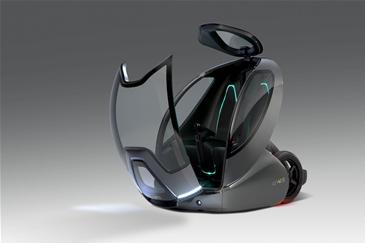GM Rides a Rickshaw to China
Last year when GM first introduced a prototype two-person vehicle called Puma, which is based on the two-wheeled Segway platform, I was intensely skeptical. It was designed for cities, supposedly, but it looked like it would get squashed like a grape by massive taxis on the streets of Manhattan. After I took a test spin, I was partly won over–it was responsive, fun to drive and, since it could turn in place, easily maneuverable. But it still seemed like a doomed idea.
Now that GM’s taken an updated version to China, however, I think I get it. This week it’s been showing off an updated version of the vehicle, called the EN-V, at the World Expo in Shanghai, a city where the vehicle makes perfect sense. Drivers there are already used to dodging scads of bicycles and scooters and wandering pedestrians. Commuters there show no fear of squashing–outside of subway stations they jump on the back of motorcycle “taxis,” which tear off recklessly through crowds, the passenger wearing no helmet. As people can afford it, they’re switching from bikes to cars to get out of the rain and smog, and that’s making traffic jams ever worse. The EN-V would be a perfect alternative, one that would ease congestion and smog alike.
And the new versions of the vehicle being demonstrated there look a lot more solid, spacious, and stylish than the first prototypes. I can imagine people wanting to buy them and be seen in them.

Keep Reading
Most Popular
Large language models can do jaw-dropping things. But nobody knows exactly why.
And that's a problem. Figuring it out is one of the biggest scientific puzzles of our time and a crucial step towards controlling more powerful future models.
The problem with plug-in hybrids? Their drivers.
Plug-in hybrids are often sold as a transition to EVs, but new data from Europe shows we’re still underestimating the emissions they produce.
Google DeepMind’s new generative model makes Super Mario–like games from scratch
Genie learns how to control games by watching hours and hours of video. It could help train next-gen robots too.
How scientists traced a mysterious covid case back to six toilets
When wastewater surveillance turns into a hunt for a single infected individual, the ethics get tricky.
Stay connected
Get the latest updates from
MIT Technology Review
Discover special offers, top stories, upcoming events, and more.